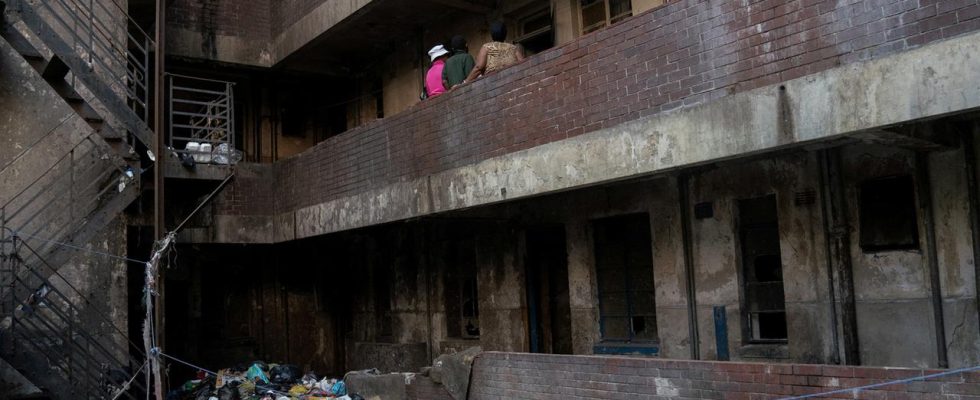77 people died in late August when a house in Johannesburg that had been “hijacked” by gangs caught fire. There are hundreds of such buildings here – they are a symbol of failure and decay. Can the city still be saved?
Number 80, Albert Street. This will be a symbol of hell on earth for the people of Johannesburg for a long time to come. On August 31, shortly after midnight, a candle had apparently fallen over. Within a very short time, the five-storey building was on fire. More than 200 families lived here, but even before the fire one could not speak of a decent life in this house.
The residents were trapped. The emergency exits were closed, as were the actual house entrances, which were closed with heavy bars so that no burglars could enter the house at night. 77 dead, including 12 children, 88 injured. Most of them suffocated at the blocked exits, many burned beyond recognition. Most of the victims remain unidentified to this day.
During the apartheid era, there was an authority in the building, the so-called “Department for Non-European Affairs”. At that time, during the segregationist era, Johannesburg was a city where only white people could move freely. European newspapers were available in the cafés, there was a tram, and there was little crime.
77 residents of 80 Albert Street burned to death. The emergency exits were closed and the actual house entrances were also closed with heavy bars.
Organized crime took control
However, people with black skin had to show a pass in order to be able to enter the city center in the morning, work there, and return to the slums of the metropolis in the evening. Then apartheid ended. In 1994, Nelson Mandela became the first black president of South Africa after the first truly democratic elections.
But the white ones? They left the city center, afraid that now it was their turn to be oppressed. Architecturally, Johannesburg was, and to a large extent still is, a city of buildings that were supposed to exude power – banks, insurance companies, government offices. The houses are still there, the former rulers are long gone.
This created a vacuum into which organized crime quickly invaded, criminals from all over the world who sensed their opportunity. Human traffickers from Mozambique, organized prostitution from Nigeria, gangs from Albania, from Great Britain, also from Germany. The city center became a “no-go area”.
700 “kidnapped” houses
The house at number 80 on Albert Street initially stood empty. At some point, when exactly no one knows, people moved into the building. People who had moved away from their homes because there was nothing but poverty there. People who were looking for work in Johannesburg every day. Migrant workers from other African countries, from Malawi, Zimbabwe, Mozambique, but also people from South Africa.
The former offices were divided with plasterboard or tarpaulins. People slept in small shacks and cooked their meals on open fires. But: They had to pay rent – to criminal gangs who had “hijacked” the house.
The building actually belongs to the Johannesburg city council. She bought it in 2019 to create parking spaces for towed vehicles. Not far away is a large Johannesburg police station. But the city administration no longer cared, so the gangsters collected the rent payments. There are over 700 such houses in downtown Johannesburg. They are a symbol of official failure, a symbol of the decline of the area, the former business center.
Lost City or “Comeback Kid”?
President Cyril Ramaphosa came on the day of the fire and said that this had to be a turning point and that the neglected areas had to be taken care of now. Hardly anyone in South Africa took him seriously.
Asyatu Madi, a woman from Malawi, said afterwards: “The fact is that we didn’t want to live here. We had to.” She jumped from the fourth floor with her six-month-old baby and broke her leg. But she and her child survived. Now their neighbors are also saying: “We no longer have a city. We have lost the city.”
Hardly anyone believes that the city administration will change things for the better here. People listen with contempt as the authorities try to justify themselves. In recent months, the mayors have changed too often, it said.
True, numerous shaky coalitions of late have resulted in mayor after mayor. But the decay of the city center goes back much further.
Shortly before and during the 2010 World Cup, there were a few promising attempts to make the city center livable and even safe again. But after a few years the situation worsened again. Now an aid organization is trying a new approach, the “Jozi My Jozi” initiative. “Jozi” is Johannesburg’s old nickname.
There are a few banks behind the organization, but also a fast food chain and Microsoft. Schools should be built, companies should resettle, “kidnapped” houses should be cleared and playgrounds built next to them. It is completely unclear whether the initiative will be successful. But organizers hope they can pull it off. They already have a new nickname for downtown Johannesburg: “Comeback Kid”.

